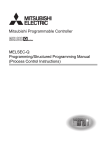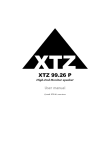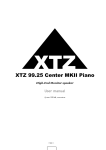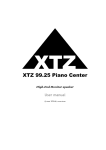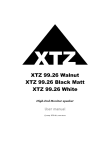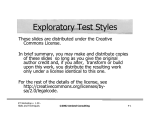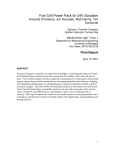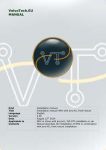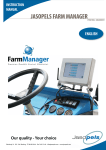Download Developing a Solution Approach
Transcript
IENG 471 Fall 2006 Lesson Four Developing a Solution Approach Lesson Four Developing a Solution Approach Table of Contents 1. 2. 3. 4. 5. 6. 7. 8. 9. 10. 11. 12. 13. 14. 15. 16. 17. 18. 19. Why You Need This Lesson ................................................................................... 1 What Is In This Lesson ............................................................................................ 2 Asking the Right Questions.................................................................................... 3 What is the Current Situation?............................................................................... 4 Design Tools for Analyzing the Current Situation ............................................. 5 What Do We Want? ................................................................................................. 6 Design Tools for Deciding What We Want .......................................................... 7 How Do We Solve the Problem?............................................................................ 8 How Do We Solve the Problem? (continued) ...................................................... 9 How Do We Solve the Problem? (continued) .................................................... 10 Design Tools for Solving Problems ..................................................................... 11 Design Tools for Solving Problems (continued)................................................ 12 Design Tools for Solving Problems (continued)................................................ 13 How Do We Test Our Solution? .......................................................................... 16 Design Tools for Testing Solutions...................................................................... 17 How Do We Keep Our Solution Working?........................................................ 18 Design Tools for Review/Renewal/Redesign................................................... 19 Summary ................................................................................................................. 20 Assignment ......................................................................................................... 21 1 1. Why You Need This Lesson Engineers are employed by organizations because they have a set of design tools for analyzing problems. These tools are what distinguish them from others who do more intuitive analysis of situations. Unfortunately inexperienced engineers don’t use the design tools they have learned. One reason for this is that they can’t identify the design tool that might work best in a given situation. Read the case study. Cindy didn’t know that she could have used an analytical tool to examine the problem she was studying. Case Study: Cindy was an intern working at Compact Insurance, a major insurance provider for the energy industry. She was asked to examine the staffing levels in their claims processing unit. Cindy collected time study data on the claims adjusters. She then did a capacity analysis of the processing unit. She identified the bottleneck in the process and proposed that the organization hire more staff. When she gave her report, she was asked the question: “Did you look at possibly doing the work in a different way so we can meet our current requirements without additional staff?” While Cindy had a course in process improvement, she never considered examining the actual work processes themselves. 2 2. What Is In This Lesson Developing a solution approach is one of the most difficult challenges a young engineer can face. Students tend to learn about design tools in discrete classes. Rarely do students learn how to integrate tools from different classes to solve a problem. After you complete this lesson, you should be able to: Select the best design tools for analyzing the current situation. Select the best design tools for determining the requirement for an effective solution. Select the best design tools for solving the problem. Select the best design tools for testing the solution. Select the best design tools for keeping the solution working. 3 3. Asking the Right Questions One way to think about a design situation is to ask the right questions. All too often we don’t ask enough questions. As a result, we solve the wrong problem. In our previous case study, Cindy didn’t ask questions about the current process. The solution she proposed involved extra staff when extra staff may not have been needed. The questions you need to ask are these: What is the current situation? What do we want? How do we solve the problem? How do we test the solution? How do we keep the solution working? 4 4. What is the Current Situation? The starting point for any project is to understand what the current situation is. Often the problem you thought existed is a symptom for another problem. In other cases you will find that you need to make fundamental changes in the current system before you can develop an overall solution approach. You might want to ask these questions as part of your understanding of the current situation. Place a checkmark in any box where you believe further analysis is needed. Include this analysis in you assignment for this lesson. Is the correct work being done? Are only necessary tasks being done? Is rework excessive? Is value added with every task? Is the work being done efficiently? Are the employees sufficiently trained? Are the best work methods being used? Is the right equipment being used? What is the effect of variability on the performance? Can variability be reduced? Are extra resources used to manage the variability? Are the customers being served by the current situation? What does the customer value the most? Are we meeting the customer’s requirements? Can we meet our customer requirements more efficiently? What are the capabilities of the current situation? How many can we do? What different things can we do? What more could we do? Is the current situation meeting expectations with regard to? Safety Quality On time performance Cost 5 5. Design Tools for Analyzing the Current Situation There are a number of design tools for analyzing the current situation. These include: Work method analysis Ergonomic task analysis Capacity analysis Fishbone diagram 5S analysis Process capability analysis While not every situation will require the use of each of these analysis tools, there should be some structured analysis tool used in examining the current situation. Often the analysis of the current situation will lead to solutions that are different from what was first envisioned. While we often look for new approaches, the best solution in many cases is to fix our current approach. What design tool(s) will you use for analyzing the current situation? Describe why you made this selection. This is part of the assignment for this lesson. 6 6. What Do We Want? Once we have an idea of the current situation, we can then begin to think about what we want. Do we want to make incremental improvements or do we want to make dramatic improvements? All too often we are too modest in thinking about the improvements we can make. Here are some questions you might ask to get at what you want: What will improvement mean for the organization? What level of improvement will it take to justify the investment in this effort (remember your time is an investment)? What are the improvement tradeoffs (e.g., time-safety, quality-cost)? Who wants improvement and who doesn’t? What are the improvement conflicts? Not everyone wants improvement. Whenever you are analyzing a situation, you need to get a clear picture of what you want. You need to match your solution approach to the improvement you want. 7 7. Design Tools for Deciding What We Want There are a number of design tools that help us decide what level of improvement we want. These include: Quality function deployment (QFD) Tradeoff analysis Cost effectiveness analysis Value analysis QFD is useful for capturing what the various stakeholders want from the solution. Tradeoff analysis helps us look at the conflicting aspects of improvement where improvements in one aspect lead to decline in another aspect. Cost effectiveness analysis and value analysis look at the financial tradeoffs in improvement. No matter what the project is, you need to do some type of requirements analysis up front. Without a requirements analysis, you are likely to develop a solution that doesn’t fulfill the needs of people affected by the system you are studying. What design tool(s) will you use for your requirements analysis? This is part of the assignment for this lesson. 8 8. How Do We Solve the Problem? The key in any project is to identify the proper approach for solving the problem. Rarely does this approach involve just one design tool. Often you will need to use a mix of approaches to get the answer you want. Here are some topics which form the basis for the questions you might ask yourself in thinking about your solution approach. 1. 2. 3. 4. 5. 6. Employees Work methods/solutions Safety Work place environment Technology Facilities 7. Work processes and business practices 8. Customer requirements 9. Information 10. Materials 11. Logistics 1. If employees are a major concern, which of the following might apply? Training Number available Work effort Staffing assignments Compensation Work motivation 2. If work methods or work stations are a major concern, which of the following might apply? Work tasks being performed Work efficiency Work station design Work ergonomics 3. If safety is a major concern, which of the following might apply? Work environment Employee/technology interactions Workplace hazards Safe work practices Safety compliance 9 9. How Do We Solve the Problem? (continued) 4. If workplace environment is a major concern, which of the following might apply? Ventilation Hazardous materials Employee protection Workplace environmental controls 5. If technology is a major concern, which of the following might apply? Reliability Maintenance practices Capability Access Employee technology/interaction 6. If facilities are a major concern, which of the following might apply? Layout Human compatibility Space utilization Operations flow Energy 7. If business processes are a concern, which of the following might apply? Work organization Control systems Work policies Resource allocation Work planning 8. If customer requirements are a major concern, which of the following might apply? Capability to meet requirements (timeliness, cost, performance, quality, etc.) Variability in support required 10 10. How Do We Solve the Problem? (continued) 9. If information is a major concern, which of the following might apply? Access/availability Timeliness Usefulness Systems 10. If materials are a major concern, which of the following might apply? Quality Availability Utilization Materials handling Storage Cost Reordering practices 11. If logistics are a major concern, which of the following might apply? Strategy Carrier selection Cost Packaging Warehousing Once you have checked off the boxes that apply, you will find some design tools on the next page that you might want to use. Include your analysis of these topics in the assignment for this lesson. 11 11. Design Tools for Solving Problems Every problem is different and the solution approach you select will have to focus on the specific needs of the problem. Outlined below are tables that will help you connect one of the concerns with solution approaches you might want to use. Let’s look at employee concerns. The approaches you might use are shown below. Employee Focused Solution Approaches Employees as a Concern Training Work Effort Compensation Employee numbers Staffing assignments Work motivation Other concerns which might be impacted Structured Job Training Job Evaluation and Design Compensation Systems Design Performance Appraisal Systems Staffing Models X X X X X X X X X X X Work methods Business processes Safety Technology information X X Work methods Work methods Technology Business processes Here’s an example of how to interpret this table: Structured job training is a design approach for helping employees understand what they need to do to perform their jobs. Obviously this approach focuses on training, but it can also affect staff assignments because it can help make the workforce more flexible. A better trained employee can also be a more motivated employee. If you checked off any employee concerns on the previous analysis, indicate the design tools you will use to solve the problem. This is part of the assignment for this lesson. 12 12. Design Tools for Solving Problems (continued) Outlined below are additional solution approaches for the other concerns. Work Methods Focused Solution Approaches Work Methods as a Concern Work tasks performed Work efficiency Work station design Work ergonomics Other concerns which might be impacted Method Analysis Ergonomic Design X X X Employees Facilities Business processes X X Employee safety Facilities Work Standards X X X Employees Safety Focused Solution Approaches Safety as a Concern Work environment Employee/technology interactions Workplace hazards Safe work practices Safety compliance Other concerns which might be impacted Risk Reduction Analysis X X Safety Audits Ergonomic Design X X Safety Program Design X X X X X Workplace environment Technology Facilities X X X Workplace environment Technology Facilities X X X Workplace environment Business processes X Workplace Environment Focused Solution Approaches Workplace Environment as a Concern Ventilation Hazardous materials Employee protection Environmental controls Other concerns which might be impacted Industrial Hygiene Analysis X X X X Safety Technology Facilities X X Employees Work methods Workplace environment Facilities 13 13. Design Tools for Solving Problems (continued) Technology Focused Solution Approaches Technology as a Concern Reliability Capability Maintenance Capacity Employee/technology interaction Work motivation Other concerns which might be impacted Maintenance Program Design X Reliability Analysis Capacity Analysis X Ergonomic Design Design for Manufacturing X X X X X X Business Customer processes requirements Facilities Based Solution Approaches Facilities as a Concern Layout Space Utilization Operations Flow Human Compatibility Energy Other Concerns which might be impacted Layout Models X X X Solution Process Maps X X X Energy Audits Ergonomic Design X X X Work methods Safety Work place environment Technology Business processing Customer requirements Materials Logistics Work methods Technology Business process Customer requirements Materials Logistics X Technology Work Methods Safety Workplace environment Technology 14 Business Processes Based Solution Approach Business Processes as a Concern Work Organization Work Policies Work Planning Control Systems Resource Allocation Other Concerns which might be impacted Work Redesign Capacity Analysis Operations Planning and Control Linear Programming X X X Work methods Technology Facilities Customer requirements Customer requirements X X Information Logistics X Customer requirements Customer Requirements Based Solution Approach Customer Requirements Capability Variability Other Concerns which might be impacted Simulation X X Technology Business Processes Logistics Quality Control Models X X Technology Value Engineering X Information Based Solution Approach Information as a Concern Access/Availability Timelines Usefulness Systems Other Concerns which might be impacted Information Systems Design X X X X Business Processes Customer requirements Decision Support Systems X X Business processes Customer requirements 15 Materials Based Solution Approach Materials as a Concern Quality Control Quality Availability Utilization Material Handling Storage Cost Other Concerns which might be impacted Inventory Models Planning X X X X X Warehouse Models Materials Handling Systems Design X X X X X X X Customer requirements Business processes Customer requirements Information Logistics Business processes Information Logistics X X X X Technology Facilities Logistics Facilities Logistics Logistics Based Solution Approach Logistics as a Concern Strategy Carrier Selection Cost Packaging Warehousing Other Concerns which might be impacted Supply Chain Modeling X Warehouse Models X X Logistics System Design X X X Packaging Models X X Technology Business processing Customer requirements Information Materials X Technology Facilities Customer requirements Information Materials X Technology Facilities Business Processes Customer requirements Information Materials Customer requirements Indicate the design tools you will use for addressing any of the concerns you checked off. This is part of the assignment for this lesson. 16 14. How Do We Test Our Solution? Once we have developed a solution, the solution will need to be tested. Solutions which appear to be good on paper often don’t work out in application. In some cases, solutions can be tested on paper but most of the time solutions need to be tried out. Here are some questions you might want to ask yourself when testing you solutions. How sensitive is my solution to o Assumptions I made? o Data I used? How might I test my solution without making expensive and perhaps risky changes? Have I considered everything important in my solution? Is my solution worth the investment it will require to implement? What might go wrong with my solution during and after implementation? In very few cases, can we be assured that the solution we developed will work exactly as we think it will? That’s why testing of the solution needs to be a part of our overall design. How would you test your solution? This is part of the assignment for this lesson. 17 15. Design Tools for Testing Solutions There are a few design tools you can use for testing whether your solution is a good one. Sensitivity analysis is good for looking at the impact of assumptions and data on the solution. This is a simple approach you can use since it simply involves running your model again with different conditions. When you find conditions that greatly affect you outcome, you need to examine them more carefully before you make recommendations. Simulation is another way to test solutions. Simulation is especially useful when the changes you recommend are likely to be costly or disruptive. Simulation models do take time to develop. Contingency analysis is more qualitative, but it can be useful in testing you solution. In this case you develop scenarios of possible things that could happen. Then you work through how your solution approach will handle these possibilities. Pilot testing is another approach you might use. In this case, you set up an experiment where you test your solution in a controlled environment. While you can’t test all contingencies, a pilot test can be useful in identifying problems that might develop as you solution is implemented. Conversations with those affected by your solution can help also be useful. No one likes to change, so you need to carefully think about whether a concern is a legitimate one or just a defense against change. Finally every solution approach needs to have a cost-benefit analysis performed. A payback period needs to be calculated as part of the solution. How will you test your solution? This is part of the assignment for this lesson. 18 16. How Do We Keep Our Solution Working? When you are working through your solution, you also need to think about how to make sure your solution is in effect after you are no longer involved. Unless you incorporate the maintenance of your solution into your design, the problem is likely to reappear or mutate to some other problem. Here are some questions you might ask about solution maintenance. How can you be sure that your solution remains in effect? How can you help those who will need to work with your solution to o keep it operating as intended? o make changes as necessary? How will the organization know when the system needs to be redesigned? No solution remains forever. People change, circumstances change, and requirements change. Solutions have a useful life just like products do. You need to think about review, renewal, and redesign as part of your overall approach. 19 17. Design Tools for Review/Renewal/Redesign The design tools for review/renewal/redesign are fairly simple in concept but more difficult in application. Here are some design tools you may want to use. Review You can develop a simple audit procedure to be used with your solution. The audit in this case would be a simple set of questions that the organization can use to ensure itself that the changes you developed stay in effect and are still appropriate. Renewal Virtually every system you can design will need a user’s manual. This manual has two purposes Make sure that new employees understand what they need to do Helps “owners” of your solution make small changes as needed Redesign Every project needs to establish a redesign date when a professional will reexamine the system to see if fundamental changes are needed. What design tools will you use for review/renewal/redesign? This is part of the assignment for this lesson. 20 18. Summary Engineers are noted for their design tools. In this lesson, we covered the selection process for design tools. Basically this process involves asking yourself questions about the problem you are solving. The questions you need to ask include: What is the current situation? What do we want? How do we solve the problem? How do we test the solution? How do we keep the solution working? 21 19. Assignment Answer the questions in each of the sections that were marked in red.























